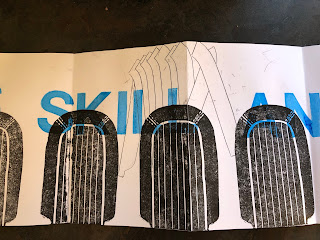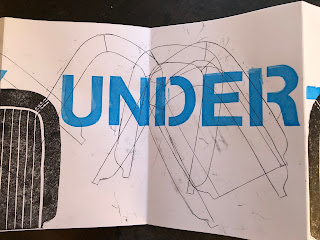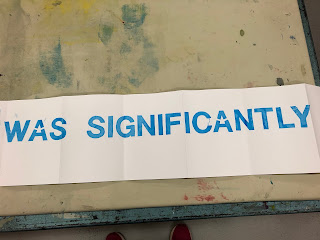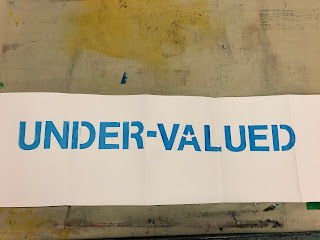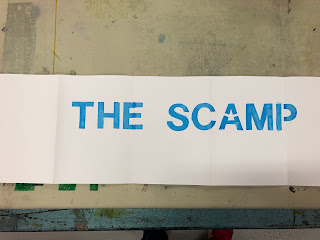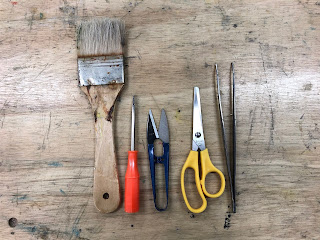What an interesting day out!
The National Archive is huge, modern building with gardens and waterside areas, close to Kew Gardens station. The building is similar in style to the Home Office and Foreign Office, and I suspect has been designed to be bomb proof.
 |
| National Archive, Kew |
I'd ordered papers on the Scamp Inquiry online, and had to register for a Reader's Ticket. Visitors access the reading room by scanning in, and have your personal possessions checked on the way in and out. Visitors are only allowed a restricted range of research tools (computer, camera, phone, pencils, notebook) and take them into the Reading Room in a clear plastic bag. Strict restrictions - no drinks, sweets, cutting implements including pencil sharpener, or water. Only box or two files on your reading space at any one time. But very helpful staff.
I'd ordered LAB 10/3313 and LAB 10/3312 regarding the Scamp Inquiry.
IR1155/1968. Ministry of Labour file. 25/6/1868. Court of Inquiry into Strike of Sewing Machinists employed at Dagenham Plant of Ford Motor Co Ltd.
There had been regrading at Ford that put staff into one of 5 bands. The job evaluation process considered 4 criteria: (p11)
Responsibility
Working Conditions
Physical Demands
Mental Demands
and considered 28 characteristics (not specified). These characteristics had 4 levels - low, medium, high, exceptional.
Machinists were separated into 3 grades - Machinist intermediate operations - who did the first stages to sew the seat together, and Machinist - finishing ops - who did seat covers, pads and linings. There was also Prototype Machinist (only 2!), both men, whose job was to do experimental trim, new materials and a wide range of operations (again not specified). (p27). Ford stated the Prototype machinists had significantly more responsibility (again unspecified). The report stated one of the characteristics for responsibility was the consequence of poor quality work at later stages of production, although this was not stated as the reason for differing grading.
The regrading exercise was discussed at the National Joint Negotiating Committee (NJNC) between unions and management. However, throughout, management concealed information regarding job grading, essential to establish the facts of the dispute. The details of how grading was assessed was concealed on the grounds of confidentiality.
About 20% of job gradings were disputed. (p27) All were meant to go through agreed Appeals Procedure and be re-evaluated by the Profile Review Committee - who were overloaded with reviews (p17). Tinsmiths and coppersmiths were regraded without appeals procedure, but on management agreement (p28). 379 alterations to job evaluation scores were accepted. 1 was rejected - the machinists (p27)
"It seemed therefore, that when management wished, it could find reasons to justify upgradings without job evaluation evidence" Scamp Report p17 London, HMSO, 1968
The machinists claimed 5 criteria (not specified) on which they believed they should be marked up, which were all in the Physical Demands criteria. They were the only B grade that had to pass tests to get the job, and these tests assessed competence on 3 machines:
Edge Cutting
Welting
Cording.
Prototype C machinists were covered when on leave, by B grade machinists. C machinists had no production target. (p26) Whereas B machinists did.
Typically C grades had tests in order to get the job. In C grade, 2 roles had one test - Eastman Cutter and Production Welder. However, some C grades had no test.
Leather cutter C grade - no test
Eastman cutter C grade - trade test. (p28)
The Leather Cutter had appealed the original job evaluation and was regraded at C grade. They had submitted 5 upgrade markings, all of which were accepted.
Ford concealed job weightings despite promising it to the unions.
p29. This failure led to suspicion and lack of confidence in management by unions.
p30. Ford never gave 'categorical' promise for disclosure. Ford reluctant to disclose weightings 'due to need for objectivity on all sides' (!)
p31 Weightings only known to Consultants (Urwick, Orr & Partners), and 2 company personnel (not specified)
p31 Consultants state it is normal practice to disclose.
p37 Cause of dispute - Machinists believed they were wrongly graded. Machinists believe job evaluation has been fiddled. Machinists lack of confidence in Job Evaluation and Weighting caused by information being withheld.
p45. Full acceptance can only come from full knowledge.
p45. Machinists job profile to be reviewed.
Inquiry panel is not trained in job evaluation criteria or weighting. Inquiry panel denies 5 characteristics in dispute are relevant (!)
Outcome: Machinists job evaluation has not been incorrectly conducted by Ford (!!!). Strike should not have taken place as union procedures not correctly followed. Recommendation that machinists jobs hold be reviewed by management (This never happened). Recommendation that leather cutter job be re-evaluated as it seemed over graded. (This never happened either).
Covering memo says "The Court is satisfied there has been no 'fiddling' by the company".
I also read the preceding notes to the Scamp Report.
Unions had banned night shifts for women. Not sure why. But the Prototype machinists (2 men) did some night work - actual amount unspecified. Apparently there was some Government encouragement of shift work in industry generally because it increased output.
Court accepted non-disclosure of weightings to them, on the grounds of confidentiality. (I find this astonishing - how can they assess what has been done and whether it is fair, if they don't understand the process for all parties?). No mention of consistency or lack of it in job evaluation assessments on common criteria.
Argument about 'objectivity'. Need for process to be objective. But it wasn't! 1968 was probably prior to management theory arguments questioning whether any process can truly be objective.
Claims in paperwork that process will be impartial. My reading is that it is Masculinist. Lots of the underlying assumptions give priority to male preference.
Trades test applied to machinists in B grade are justified by Ford on the grounds that there is no alternative role to transfer them to, if they don't make the grade. Whereas if men in a B grade don't make the grade, there were plenty of roles into which to transfer them. I question how far management have looked for roles into which to transfer women! Different standards for the genders - B women get tested, B men don't!
All assessors were management. Union rep was specifically excluded.
Job evaluation gradings were reviewed by management CRC (C? Review Committee) and Consultant, not DRC (Divisional Review Ctte). Consultant agreed assessor markings without visiting the sites and staff, in his role to check assessments. DRC submitted upgrading requests, and Consultant did not tell them them their recommendations were ignored.
3 machinist profiles.
Prototype machinists were in Research & Development, thus were deemed a C grade.
Finisher and Intermediate machinists worked in the Body Plant, an assembly operation, therefore B. But they had to have an Excellent profile (not specified why).
Constantly fudging the scoring. The Leather Cutter has very similar working environment to machinists (factory shed), yet he is scored as a medium working environment, whereas they are classified as low environment, (normally office type accommodation).
Men's roles appear to be rounded up (lower skilled Leather Cutter is associated with Eastman Cutter, so both get C grade)
Women's roles appear to be rounded down (lower skilled intermediate machinist is associated with finisher machinist, so both get B grade).
Record of Proceedings at Court of Inquiry 3/7/68. H Friedman, AUEFW argues that skilled craftsmanship is what is important, and this is what the job should be evaluated on, not working conditions.



